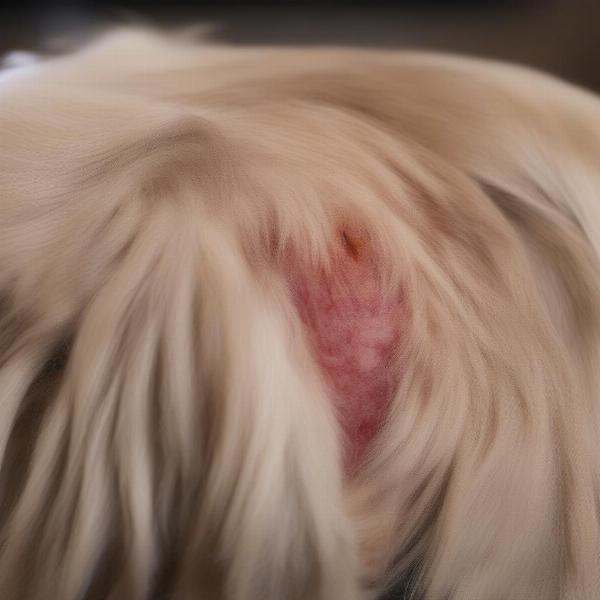Finding the right food for your dog can be a challenge, especially if they have dietary sensitivities. If you’re searching for yeast-free dog food in the UK, this comprehensive guide will equip you with everything you need to know. We’ll explore the reasons why yeast might be problematic for some dogs, discuss the benefits of a yeast-free diet, and guide you through choosing the best option for your furry friend.
Understanding Yeast Sensitivity in Dogs
Why might a dog need yeast-free food? Yeast is a naturally occurring fungus, and while small amounts are generally harmless, an overgrowth can lead to various health issues. This overgrowth, often called a yeast infection, can manifest in several ways, from itchy skin and ear infections to digestive problems. Identifying these symptoms early is key to managing the issue effectively.
 Dog with Yeast Infection on Skin
Dog with Yeast Infection on Skin
Benefits of a Yeast-Free Diet for Dogs
Switching to a yeast-free dog food can bring significant relief for dogs suffering from yeast-related problems. By removing the potential trigger, you can help address the root cause of the issue rather than just managing the symptoms. A yeast-free diet can lead to healthier skin, reduced itching and scratching, improved digestion, and an overall boost in your dog’s well-being.
Choosing the Right Yeast-Free Dog Food in the UK
The UK market offers a variety of yeast-free dog food options, so how do you choose the right one? Look for foods that avoid common yeast sources like brewers’ yeast, dried yeast, and yeast extract. Prioritize high-quality ingredients, including lean proteins, healthy fats, and digestible carbohydrates.
Reading Dog Food Labels for Yeast-Free Options
Navigating dog food labels can be tricky. Look for clear labeling stating “yeast-free” or “no yeast added.” Carefully scrutinize the ingredient list to ensure no hidden sources of yeast are present.
What if I can’t find “Yeast-Free” Dog Food?
If explicitly labeled yeast-free food is unavailable, consider limited ingredient diets or hypoallergenic options. These formulations often exclude common allergens, including yeast, and can be a good alternative. Consult with your veterinarian for personalized recommendations based on your dog’s specific needs.
Transitioning to a Yeast-Free Diet
Introducing a new food should be a gradual process. Start by mixing a small amount of the yeast-free food with your dog’s current food. Gradually increase the proportion of yeast-free food over several days to a week, allowing your dog’s digestive system to adjust.
“A gradual transition to a new diet is crucial for preventing digestive upset,” says Dr. Emily Carter, a veterinary nutritionist based in London. “This allows the gut microbiome to adapt to the new food and minimizes the risk of diarrhoea or vomiting.”
Maintaining a Yeast-Free Lifestyle
Once your dog is fully transitioned to a yeast-free diet, consistency is key. Avoid giving treats or table scraps containing yeast. Regularly clean your dog’s food and water bowls to prevent yeast growth. Monitor your dog’s skin and ears for any signs of recurring yeast issues.
“In addition to diet, maintaining a healthy gut microbiome is essential for long-term yeast control,” adds Dr. Carter. “Probiotics and prebiotics can be beneficial in supporting a balanced gut flora.”
Conclusion
Choosing yeast-free dog food in the UK requires careful consideration and understanding of your dog’s needs. By following the guidelines outlined in this article, you can confidently select a suitable option and support your furry companion’s journey to better health. Remember to consult with your veterinarian for personalized advice and to address any specific concerns.
FAQ
- What are the common signs of yeast sensitivity in dogs? Itching, redness, hair loss, ear infections, and digestive problems can be indicators of yeast sensitivity.
- Is all yeast bad for dogs? Small amounts of yeast are generally harmless, but an overgrowth can cause health issues.
- Can I make my own yeast-free dog food? While possible, it’s crucial to ensure a balanced diet. Consult with a veterinary nutritionist for guidance.
- How long does it take to see results from a yeast-free diet? Improvements can be seen within a few weeks, but individual responses vary.
- What if my dog doesn’t like the yeast-free food? Try different brands or flavors to find one your dog enjoys.
- Are there any side effects of a yeast-free diet? Generally, yeast-free diets are safe, but consult your vet if you notice any unusual changes.
- Where can I buy yeast-free dog food in the UK? Many pet stores and online retailers offer a variety of options.
ILM Dog is a leading online resource for dog owners worldwide, offering expert advice on all aspects of dog care, from breed selection and health to training and nutrition. We strive to provide practical, reliable information to help you make informed decisions for your beloved canine companion. Whether you’re a new dog owner or a seasoned expert, ILM Dog is your go-to source for valuable insights and resources. Contact us at [email protected] or +44 20-3965-8624 for personalized guidance. We are passionate about helping you nurture a strong, healthy, and happy bond with your furry friend. For more information on dog health and wellness, visit ILM Dog.